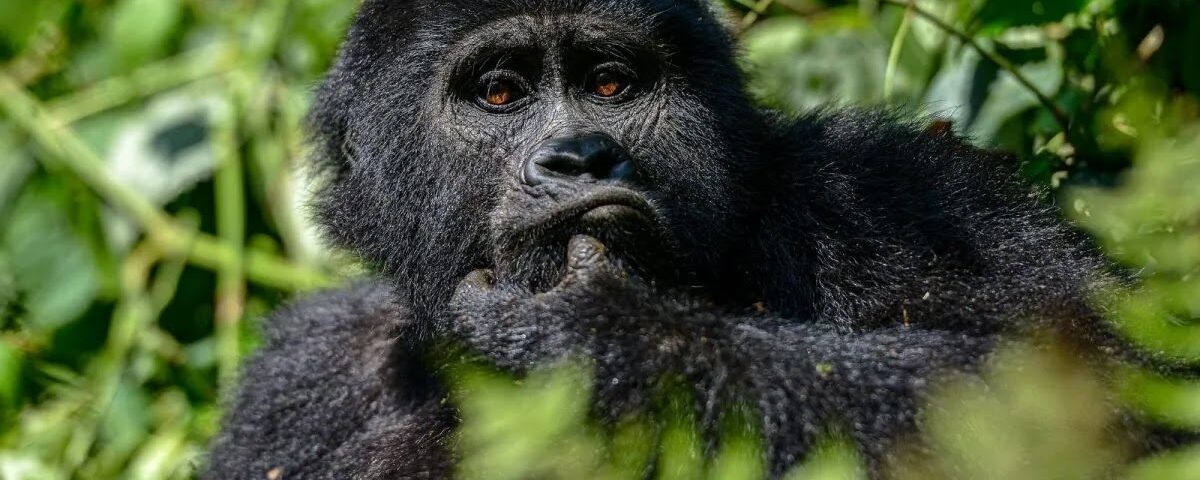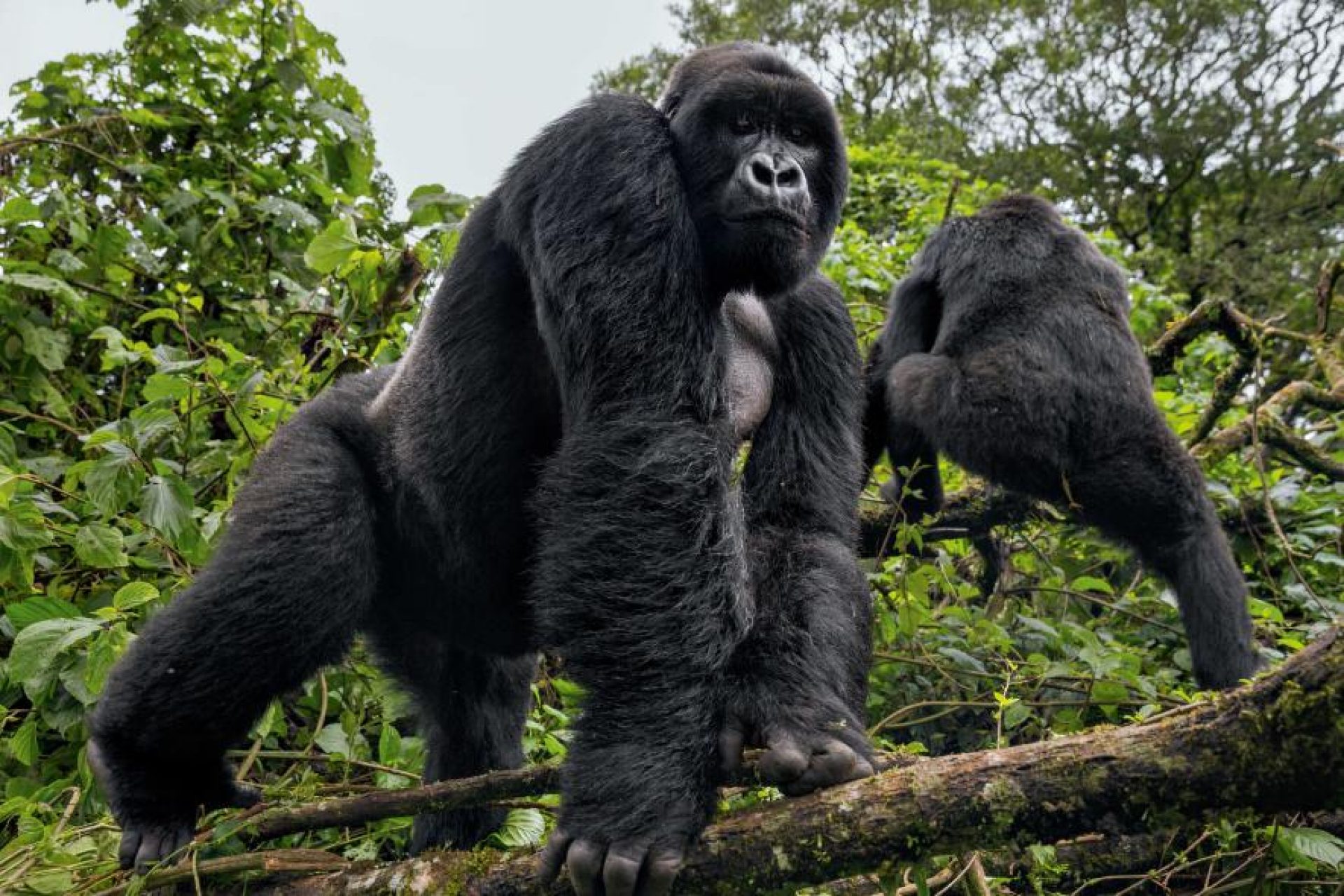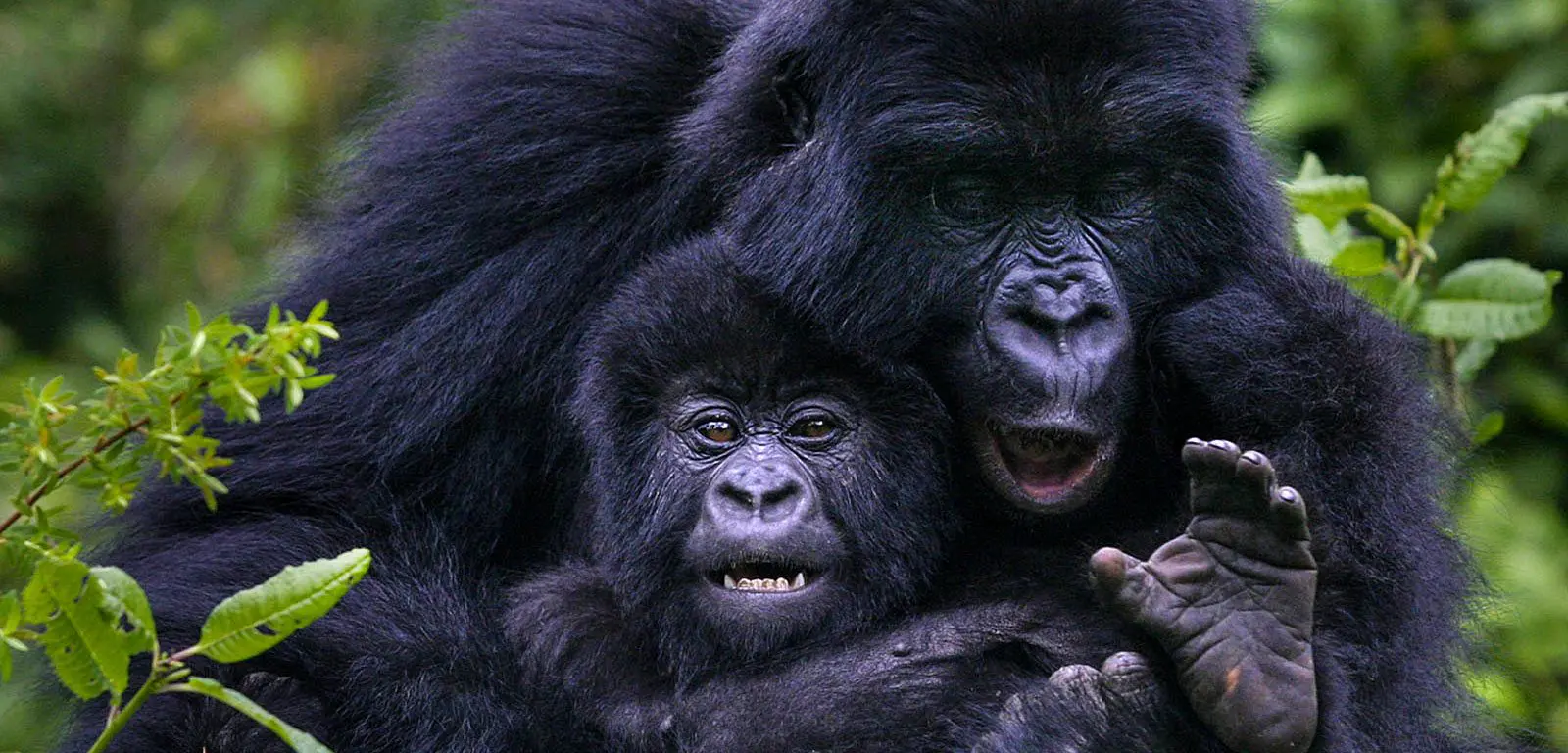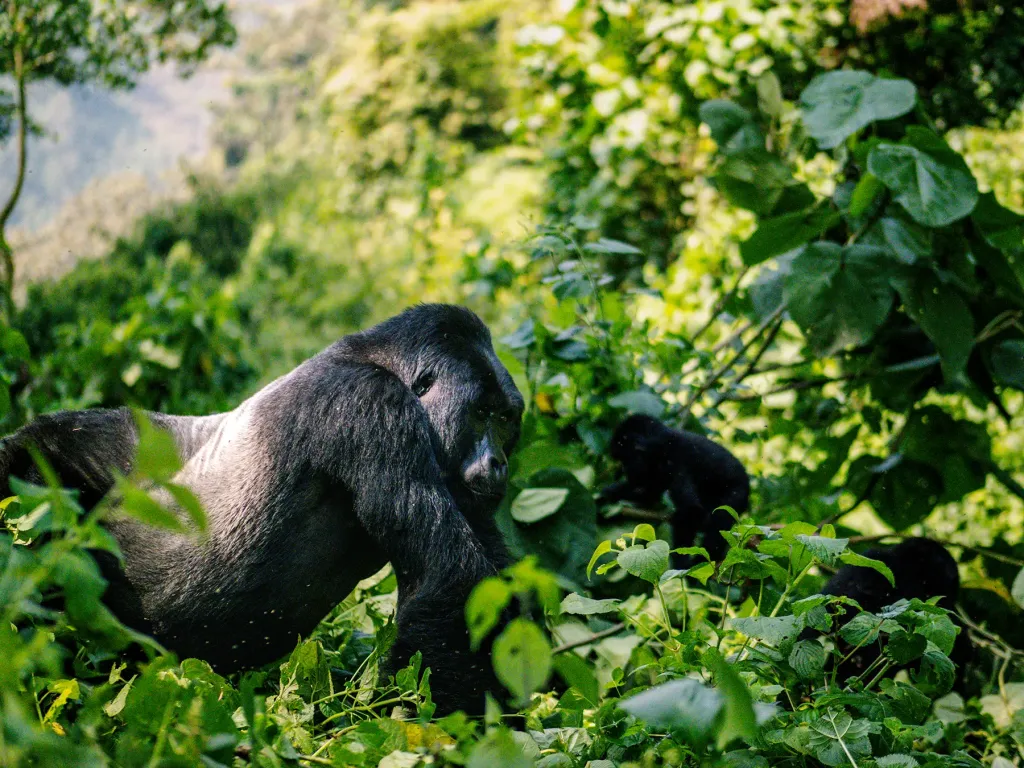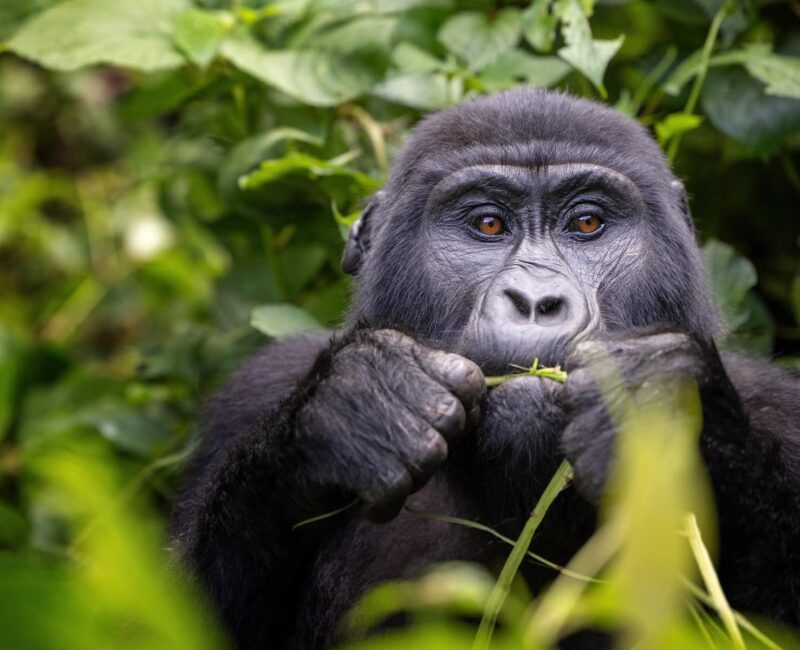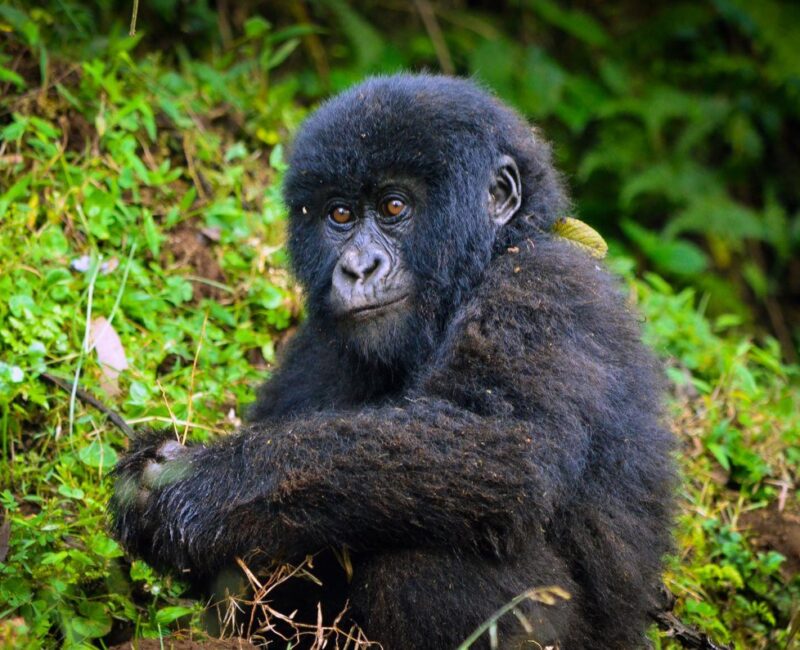
Co-existence of Gorilla Families in Uganda
September 30, 2025
Gorilla Conservation in the Virunga Conservation Area
October 6, 2025Gorilla Behavioral Adaptations: Insights from Uganda Gorilla Safaris
Why Understanding Gorilla Behavior Enriches Uganda Gorilla Safaris
Travelers embarking on a Uganda Gorilla Safari often anticipate close encounters with mountain gorillas, but the real magic unfolds when observing their behavior. Beyond their size and power, gorillas display fascinating behavioral adaptations that ensure survival in challenging habitats. Every chest-beat, soft grunt, or tender grooming gesture tells a deeper story about their resilience and intelligence.
These adaptations are not random habits. They are survival strategies developed over centuries, allowing gorillas to thrive in high-altitude forests and dense vegetation. When visitors choose Uganda Gorilla Trekking, they witness firsthand how gorillas rely on complex communication, social bonds, and protective group living to overcome environmental challenges.
By understanding these behavioral patterns, a trek transforms from a simple wildlife encounter into a meaningful journey. Observers see not only the majesty of gorillas but also their adaptability. Whether it is watching a silverback lead his group, hearing low rumbles exchanged among females, or noticing how infants practice play-fighting, each moment reveals why gorillas remain Africa’s most iconic primates.
For travelers planning Uganda Safaris Holidays, this knowledge builds anticipation and ensures richer storytelling when reflecting on their adventures. It also reinforces why protecting these primates and their habitats matters, not just for tourism but for global biodiversity.
Social Behavior: The Foundation of Gorilla Survival
Gorilla behavioral adaptations are most evident in their strong social structures. Every family group, known as a troop, is led by a dominant silverback. This role carries immense responsibility, as he guides daily movement, ensures access to food, and provides protection. His authority is rarely challenged, and his calm leadership forms the backbone of gorilla society. Observers on Uganda Gorilla Trekking adventures often notice the respect other members show toward him.
Family bonds form another cornerstone of gorilla social behavior. Adult females and their offspring rely heavily on the silverback’s protection. Grooming rituals between members reinforce trust, reduce tension, and maintain harmony within the troop. Young gorillas, often seen clinging to their mothers or playfully wrestling with siblings, strengthen bonds that will shape their future roles. Travelers on Uganda Gorilla Safaris witness these tender interactions, gaining insights into the emotional depth of gorilla families.
Another fascinating adaptation lies in the troop’s cooperative lifestyle. Living together enhances safety from external threats, while also ensuring that young gorillas learn essential survival skills. Diurnal habits, with activities focused during daylight, align with their need for visibility, food availability, and group cohesion. These behaviors reflect not just instinct but also intelligent adaptation to forest life.
Such social organization creates unforgettable memories for visitors. For those booking Uganda Safari Holidays, these behavioral insights elevate the journey into an educational and emotional experience. Understanding why gorillas live this way adds depth to what travelers see on their Uganda Wildlife Safaris.
Communication: The Language of the Forest
Effective communication is another essential gorilla behavioral adaptation. Gorillas rely on a wide range of vocalizations and body language to coordinate group life. Their language is surprisingly complex, enabling them to share warnings, express comfort, and resolve conflicts. For visitors on Uganda Safaris, these moments highlight gorillas’ intelligence and emotional capacity.
Vocalizations range from soft grunts used to maintain contact during feeding to loud barks or roars that signal alarm. Infants often produce playful squeaks, while mothers use gentle sounds to reassure them. Experienced trekkers on Uganda Wildlife Tours quickly notice how distinct each sound feels, reflecting the richness of gorilla communication.
Body language complements vocal communication. Expressive eyes, posture changes, and movements convey emotions such as curiosity, irritation, or reassurance. One of the most famous displays is chest-beating. Contrary to misconceptions, chest-beating often serves as a non-violent threat display rather than an invitation to fight. By showcasing strength, silverbacks discourage rivals and protect their families without unnecessary conflict. Witnessing this iconic display during a Uganda Gorilla Safari leaves travelers with lifelong memories.
These communication strategies emphasize harmony and efficiency within the group. They also reveal gorillas’ preference for peaceful solutions, a trait that surprises many visitors expecting constant aggression. By observing these adaptations during Uganda Tours, travelers leave with a deeper appreciation of gorilla intelligence, realizing that these animals are not just powerful but profoundly social beings.
Diet and Digestion: A Behavioral Link to Survival
Gorillas’ feeding behavior demonstrates another remarkable adaptation. Their herbivorous diet requires significant time and energy, as they consume leaves, stems, fruits, and bark in large quantities. Observers on Uganda Gorilla Safaris Holidays often find families scattered in feeding zones, calmly plucking vegetation and chewing methodically. This slow, deliberate feeding is essential to fuel their large bodies.
Behaviorally, gorillas organize their day around feeding, resting, and moving to new foraging areas. Silverbacks often lead the group to fresh feeding grounds, ensuring access to sufficient vegetation. This routine reflects a deep understanding of their environment and the availability of resources. Tourists on Uganda Wildlife Safaris quickly recognize how structured and purposeful these daily patterns are.
Efficient digestion complements feeding behavior. Gorillas have developed specialized gut bacteria that ferment fibrous plant matter into usable energy. This adaptation allows them to survive on vegetation that would be indigestible to many animals. Their large colons and extended digestive tracts enable prolonged fermentation, turning tough stems into nourishment.
Travelers watching gorillas feed during Uganda Wildlife Tours often gain perspective on the delicate relationship between species and habitat. The forests of Bwindi and Mgahinga are not just homes for gorillas—they are life-sustaining pantries. Protecting these ecosystems ensures that gorillas continue to thrive, making Uganda Safaris not just tourism experiences but conservation journeys.
Locomotion and Nesting: Unique Daily Routines
Gorillas display distinctive locomotion patterns that reflect evolutionary adaptation. Knuckle-walking, their primary mode of movement, allows efficient travel through dense forests. By supporting their weight on curled fingers, they protect delicate hands while maintaining strength for climbing and foraging. Visitors on Uganda Gorilla Trekking safaris often marvel at how smoothly these giants navigate challenging terrain.
Equally fascinating is their nesting behavior. Each evening, gorillas build fresh nests from leaves and branches, either on the ground or in trees. This behavior provides comfort and safety, reducing risks from parasites and predators. Observers on Uganda Safari Holidays often encounter these nests during treks, visible reminders of gorillas’ daily rhythms.
Nesting is not simply practical—it is cultural. Mothers teach infants nest-building skills, ensuring that younger generations continue the tradition. Watching these behaviors enriches Uganda Gorilla Safaris, revealing how survival is passed down through learned practices.
These routines showcase gorillas’ remarkable adaptability. By combining efficient movement with protective resting habits, they demonstrate the balance between energy use and safety. For travelers on Uganda Wildlife Safaris, witnessing these adaptations turns a trek into an exploration of daily gorilla life.
Cultural Experiences Around Gorilla Lodges
While Uganda Gorilla Safaris focus on gorilla behavior, cultural immersion around safari lodges adds unique value to every journey. Visitors staying near Bwindi and Mgahinga can engage with Batwa communities, learning how indigenous forest dwellers once coexisted with gorillas. Storytelling, dance performances, and traditional skills like fire-making or hunting with bows connect travelers to the human side of forest life.
Lodges also organize village walks, craft workshops, and interactions with local farmers, allowing guests to explore the rich cultural heritage of Uganda. Combining Uganda Wildlife Tours with cultural activities ensures a holistic travel experience. It also strengthens community-based tourism, ensuring local people benefit directly from conservation.
For travelers booking Uganda Safaris Holidays, these cultural interactions complement gorilla encounters. By connecting with both wildlife and people, visitors gain a richer perspective on Uganda’s natural and cultural treasures. This blend makes a Uganda Safari Holiday an unforgettable journey, balancing adventure with meaningful human connections.
Why Gorilla Behavioral Adaptations Matter for Uganda Safaris
The question of “What are gorilla behavioral adaptations?” finds answers in their social bonds, communication systems, feeding habits, and protective routines. Each adaptation highlights intelligence, resilience, and harmony with nature.
For travelers on Uganda Gorilla Safaris, observing these behaviors transforms trekking into an extraordinary journey. Instead of distant wildlife viewing, visitors witness leadership, nurturing, play, and communication in real time. Every chest beat, gentle groom, or nest-building session adds depth to the safari experience.
Choosing Uganda Safari Holidays means more than adventure—it means participating in conservation and cultural preservation. By supporting Uganda Wildlife Safaris, travelers ensure that gorillas and local communities thrive together. These adaptations, passed through generations, remind us of nature’s balance and the importance of safeguarding it.
Ultimately, gorilla behavioral adaptations tell a story of survival and intelligence that resonates with every visitor. They show that Uganda is not just a safari destination but a living classroom, offering lessons in resilience, leadership, and cooperation. For those seeking unforgettable Uganda Tours, this journey delivers experiences that go beyond wildlife—it connects hearts, minds, and cultures in the heart of Africa.

